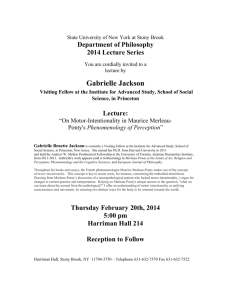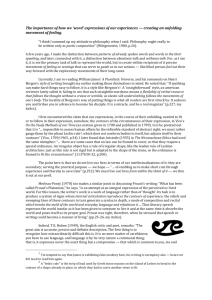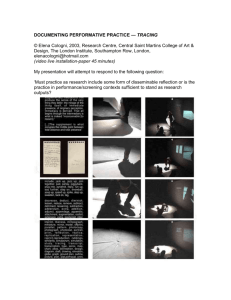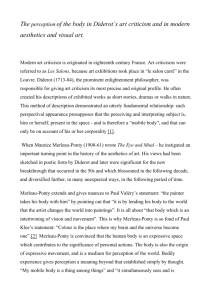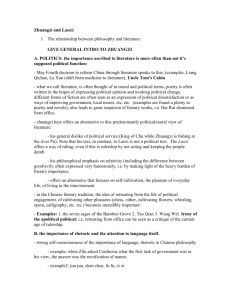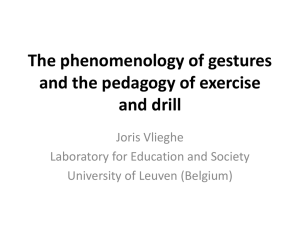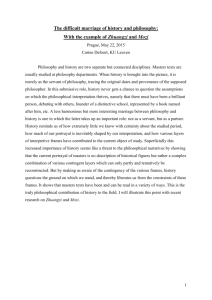Phenomenology: Cook Ding’s Ming and Merleau-Ponty’s Chiasm
advertisement
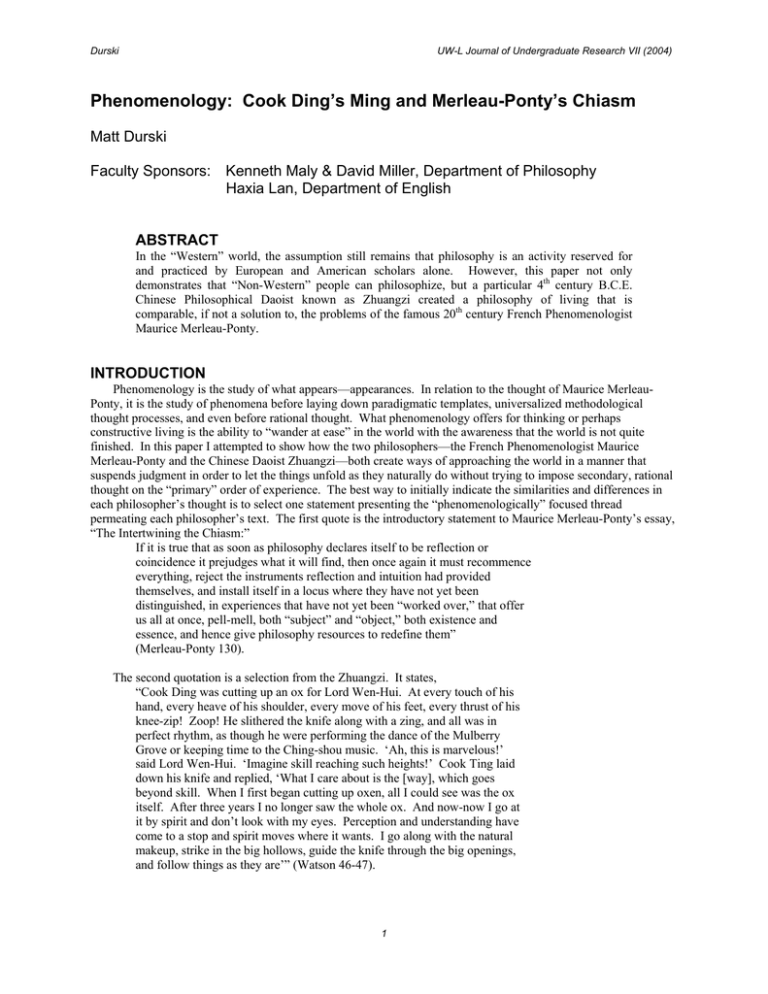
Durski UW-L Journal of Undergraduate Research VII (2004) Phenomenology: Cook Ding’s Ming and Merleau-Ponty’s Chiasm Matt Durski Faculty Sponsors: Kenneth Maly & David Miller, Department of Philosophy Haxia Lan, Department of English ABSTRACT In the “Western” world, the assumption still remains that philosophy is an activity reserved for and practiced by European and American scholars alone. However, this paper not only demonstrates that “Non-Western” people can philosophize, but a particular 4th century B.C.E. Chinese Philosophical Daoist known as Zhuangzi created a philosophy of living that is comparable, if not a solution to, the problems of the famous 20th century French Phenomenologist Maurice Merleau-Ponty. INTRODUCTION Phenomenology is the study of what appears—appearances. In relation to the thought of Maurice MerleauPonty, it is the study of phenomena before laying down paradigmatic templates, universalized methodological thought processes, and even before rational thought. What phenomenology offers for thinking or perhaps constructive living is the ability to “wander at ease” in the world with the awareness that the world is not quite finished. In this paper I attempted to show how the two philosophers—the French Phenomenologist Maurice Merleau-Ponty and the Chinese Daoist Zhuangzi—both create ways of approaching the world in a manner that suspends judgment in order to let the things unfold as they naturally do without trying to impose secondary, rational thought on the “primary” order of experience. The best way to initially indicate the similarities and differences in each philosopher’s thought is to select one statement presenting the “phenomenologically” focused thread permeating each philosopher’s text. The first quote is the introductory statement to Maurice Merleau-Ponty’s essay, “The Intertwining the Chiasm:” If it is true that as soon as philosophy declares itself to be reflection or coincidence it prejudges what it will find, then once again it must recommence everything, reject the instruments reflection and intuition had provided themselves, and install itself in a locus where they have not yet been distinguished, in experiences that have not yet been “worked over,” that offer us all at once, pell-mell, both “subject” and “object,” both existence and essence, and hence give philosophy resources to redefine them” (Merleau-Ponty 130). The second quotation is a selection from the Zhuangzi. It states, “Cook Ding was cutting up an ox for Lord Wen-Hui. At every touch of his hand, every heave of his shoulder, every move of his feet, every thrust of his knee-zip! Zoop! He slithered the knife along with a zing, and all was in perfect rhythm, as though he were performing the dance of the Mulberry Grove or keeping time to the Ching-shou music. ‘Ah, this is marvelous!’ said Lord Wen-Hui. ‘Imagine skill reaching such heights!’ Cook Ting laid down his knife and replied, ‘What I care about is the [way], which goes beyond skill. When I first began cutting up oxen, all I could see was the ox itself. After three years I no longer saw the whole ox. And now-now I go at it by spirit and don’t look with my eyes. Perception and understanding have come to a stop and spirit moves where it wants. I go along with the natural makeup, strike in the big hollows, guide the knife through the big openings, and follow things as they are’” (Watson 46-47). 1 Durski UW-L Journal of Undergraduate Research VII (2004) To help clarify how each of these passages embody phenomenological thinking in uniquely different manners, I will proceed to highlight and summarize each philosopher’s key idea in this consideration beginning with Maurice Merleau-Ponty. THE CHIASM In his famous essay, “The Intertwining-The Chiasm,” Merleau-Ponty uses the term chiasm as the source to tie together the Classical Western Philosophical subject/object dilemma which most often states that the subject—that which throws things/objects under—or the individual mind, is set apart/against the objects—that which is thrown against our subject—of everyday empirical and cognitive experience is what is most primary to cognitive understanding. What is a chiasm? The word chiasm is a French word derived from chiasma meaning, “a crossing or decussation, as that of the optic nerves at the base of the brain” (Webster’s 356). He uses this word-image of crossing nerves letting us imagine that point at which the subject and object cross at the most basic level. Keeping true to optic phenomena and the word image of chiasm, he proceeds to study the perceptual realm of experience. The first way he does this, is through the study of the color red. He concludes, “a certain red is…less a color than a difference between things and colors, a momentary crystallization of colored being or of visibility” (Merleau-Ponty 132-133). What does this mean in less esoteric language? Essentially, it means that the color red that I experience and see is not the color red you experience and see, it means the color red is contextual and relatively relative as opposed to permanent and universal. He argues this, because the color red which one perceives is dependent on how much light is present in the room, how one’s rods and cones are structured, as well as the other colors surrounding “red.” What this move accomplishes, is the breakdown of the historic duality between subject and object from the object’s perspective. We find that the object of perceptual analysis, red, is not a object containing inherent values and characteristics, but rather, red is defined by our participation with “it”. Next, Merleau-Ponty begins to study the subject in order to deconstruct the duality from the subject’s perspective. This goal is attained by studying the tactile interaction, the bodily consciousness between his two hands. When the right hand is touching the left hand, and when the left hand is touching the right hand, it is noticed that our hands become both touching objects and touching subjects. This sounds like a paradox, because if one conducts this experiment, one sees that selective perception only allows one to either feel one hand touching or being touched. However, one will also notice that both ways of feeling the touch are indeed accurate. From this we can conclude the physical sensation of the interaction between our hands, are two halves of the sentient-sensible, object-subject relationship, and thus inextricably bound to one another in some manner. This relationship, this interaction between things in primary consciousness is precisely what Merleau-Ponty labels “Chiasm,” and is precisely where he is trying to arrive when he writes about getting into a locus before things have been “worked over.” MING In his Inner Chapters, Zhuangzi uses the character for “Ming” to describe the way the sage participates in the everyday activities in the world. Before I give any further explanation of what ming means in this work, I will define ming philosophically with the Dao De Jing: A Philosophical Translation written by Roger T. Ames and David Hall. On pages 39 and 40 it states, it is “through ‘acuity (ming)’—a mirroring of the things of the world as they are in their interdependent relations with us—that we reach a state in which nothing among all of the “myriad goings on” in the world will be able to agitate our hearts-and-minds, and we are better able to promote the flourishing of our world. In other words, we defer in attaining integrity with those things that contextualize us, establishing a frictionless equilibrium with them.” For Zhuangzi, things do not intertwine in a theoretical chiasm. Rather, he thinks that we should attend to the way in which things intertwine and make meaning as they seem to fit into our contextual meaning structures of everyday life. For Zhuangzi, the sage is one who thinks that the affirmations and the denials characteristic of the Mohists and the Confucians shed light on only a glimpse of the larger picture. For example, Zhuangzi retorts, “What is It is also Other, what is Other is also It. There they say ‘That’s it, that’s not’ from one point of view, here we say ‘That’s it, that’s not’ from another point of view. Are there really It and Other? Or really no It and Other” (Graham 53)? The value of constructing this type of duality lies in showing the arrogance and futility of people who argue not to understand the other person’s perspective, but argue only because they refuse to move out of the absolute, value ridden schemes entrenching them in their unchangeable position. What one should do instead, is continuously attend to one’s surroundings, realizing that the distinction between it and other, subject and object are only “temporary lodging places” used to act appropriately to what each particular situation offers. By practicing life this way, one is able to attend, attune, and be connected on a mundane level to all experiences contextualizing our lives allowing us to become master butchers like Cook Ding. 2 Durski UW-L Journal of Undergraduate Research VII (2004) METHOD The methods with which I researched and wrote this paper consisted of: a. Taking a Phenomenology seminar course with Dr. Kenneth Maly b. Taking a Zhuangzi “Directed Readings” course with Dr. Haixia Lan. c. Discussing the philosophical aspects of Phenomenology with Kenneth Maly d. Discussing the philosophical and rhetorical aspects of Philosophical Daoism and “Chinese” thinking with Haixia Lan. e. Intense reading of Merleau-Ponty’s, “The Intertwining—The Chiasm.” f. Intense reading of A.C. Grahams, Disputers of the Tao, Zhuangzi: The Inner Chapters, Heidegger’s view of language, Roger Ames collaborative works with David Hall and D.C. Lau on the Confucian Analects, the Dao De Jing, the Zhongyong, and Yuan Dao. g. Proofreading and commenting by Dr. David Miller, Kenneth Maly, and Haixia Lan. RESULTS/CONCLUSIONS After researching this topic for a large portion of an academic year and then letting my initial conclusions alone to see if they still check out with the research, I am confident I can make a more specific and concrete description of the way Zhuangzi’s Daoism and Merleau-Ponty’s Phenomenology share and differ from one another. I also feel I am in better position to comment on how Zhuangzi’s theory of living supplements or even corrects Merleau-Ponty’s speculative ontology. To clarify my results and/or conclusions, I will cite several passages from each book and attempt to show where Daoism dehisces from Phenomenology. On page 134 of The Visible and the Invisible the French thinker writes, “he who looks must not himself be foreign to the world that he looks at. As soon as I see, it is necessary that the vision…be doubled with a complementary vision or with another vision: myself seen from without, such as another would see me, installed in the midst of the visible…” On page 135 he concludes, “It is that the thickness of flesh between the seer and the thing is constitutive for the thing of its visibility as for the seer of his corporeity; it is not an obstacle between them, it is their means of communication. It is for the same reason that I am at the heart of the visible and that I am far from it: because it has thickness and is thereby naturally destined to be seen by a body.” On page 55 of Chuang-tzu: The Inner Chapters it is said, “There is ‘beginning’, there is ‘not yet having begun having a beginning’. There is ‘there not yet having begun to be that “not yet having begun having a beginning”’. There is ‘something’, there is ‘nothing’. There is ‘not yet having begun being without something’. There is ‘there not yet having begun to be that “not yet having begun being without something’.” On page 57 Zhuangzi remarks, “To ‘divide’, then, is to leave something undivided: to ‘discriminate between alternatives’ is to leave something which is neither alternative. ‘What?’ you ask. The sage keeps it in his breast, common men argue over alternatives to show it to each other. Hence I say: “To “discriminate between alternatives” is to fail to see something’. Lastly, I will give one conundrum and one story on dreaming. Zhuangzi quips, “While we dream we do not know that we are dreaming, and in the middle of a dream interpret a dream within it; not until we wake do we know that we were dreaming. Only at the ultimate awakening shall we know that this is the ultimate dream” (Graham 59-60). “Last night Chuang Chou dreamed he was a butterfly, spirits soaring he was a butterfly (is it that in showing what he was he suited his own fancy?), and did not know about Chou. When all of a sudden he awoke, he was Chou with all his wits about him. He does not know whether he is Chou who dreams he is a butterfly or a butterfly who dreams he is Chou. Between Chou and the butterfly there was necessarily a dividing; just this is what is meant by the transformation of things” (Graham 61). What is obvious from reading these passages is the different approach each philosopher engages to encounter the dilemma of lived experience. One could say that Maurice Merleau-Ponty’s attempt to “uncover” the chiasm is doomed to fail before it even begins. The reason for this conclusion strings forth from his initial construction of duality. When in the first paragraph of “The Intertwining-The Chiasm,” Merleau-Ponty speaks of throwing away the tools that reflection and intuition had provided themselves in order to reach the primary order of experience, he is already making a duality between reflective and non-reflective thinking. After this, he constructs the dualities of subject/object, existence/essence, sensible/sentient in an attempt to recover exactly what has been missed through constructing these realities. Unfortunately, as Zhuangzi told us earlier, to divide is to leave something undivided, and to argue leaves something not argued. This then means, that Merleau-Ponty, regardless of his valiant efforts to leap over duality, failed for the very reason he began with them. As the Laozi states, before you can break 3 Durski UW-L Journal of Undergraduate Research VII (2004) something, you must build it up. Taking this further, if you never build something up in an attempt to be absolute, you will never need to break it. This is precisely the point where Zhuangzi’s theory of living surpasses and offers a solution to Maurice Merleau-Ponty’s phenomenology. However, one should not be so quick to discredit the accomplishments of this French thinker. At the time he was writing these ideas, there were few (with the exception of Heidegger, Sartre, and a few others) who were even willing to enter into this form of philosophical discourse. In fact, the work of MerleauPonty along with other European phenomenologists and American pragmatists were and continue to be instrumental in forming the East-West philosophical dialogue. LIMITATIONS There are several potential personal, theoretical, and perspectival limitations of this research. 1. 2. To be completely true to both philosophers, one would need to be extremely fluent and versed in the dialogues and languages creating the texts of Zhuangzi and The Visible and the Invisible to give a “proper” intellectual assessment of both. Another large problem when dealing with famous foreign philosophers and current philosophers who are better educated on these philosophers, is the role of translation and interpretation of language. For instance, all or almost all Chinese characters are gerundative. This means that the nouns are in action. A good example of this in English is the word rain. Rain can be both an action and a thing, thus embodying a noun and verb state. Most Chinese nouns are of this form, which means a thing is what it is because of what it does. French, on the other hand, is typically very abstract and essentialistic. This means that whenever one uses a noun, the noun is not seen as doing something, but rather, is seen as being something/having essential characteristics. This presents a problem in this form of research, because the student/researcher is at the mercy of the translator who decides whether Merleau-Ponty’s chiasm phrase is intended to be essentialistic or gerundative. If the phrase is gerundative, then Merleau-Ponty’s ideas are even closer to Zhuangzi’s and will require a reinterpretation of both texts. However, if the phrase is essentialistic, possibly leaning towards action, but not quite becoming one, then one will argue a paper in the way I did. ACKNOWLEDGEMENTS Thanks are due to many for the culmination of this research. In no particular order I wish to thank: 1. Dr. David Miller for sparking my interest in philosophy, for teaching the value of critical thinking, serving as a faculty sponsor, hiring me as a philosophy tutor, as well as introducing me to Chinese and Japanese philosophy. 2. Dr. Kenneth Maly for accepting my proposal to teach a Phenomenology seminar course, helping me get involved in research, and keeping an eye out to help focus my studies on Martin Heidegger and Maurice Merleau-Ponty. 3. Dr. Haixia Lan for teaching an amazing Chinese Discourse course, giving her time to a directed readings course on Zhuangzi, offering me an English tutoring position, and countless conversations covering Comparative philosophy, Chinese philosophy, rhetoric, and literary forms. 4. The University of Wisconsin-LaCrosse, Bill Gresens, and the Undergraduate Research Committee who allowed my research to blossom by awarding me two undergraduate research grants, one to fly me down to the University of Utah to give a lecture at NCUR (the National Conference of Undergraduate Research), and another to purchase books to write and research this paper. 5. The faculty and students of the philosophy department whose amazing ideas and passion for philosophy always kept me on top of my work and reassured me I was spending my time doing something I truly love. 4 Durski UW-L Journal of Undergraduate Research VII (2004) REFERENCES Ames, Roger T and D. L. Hall, tran, Dao De Jing: A Philosophical Translation. New York: Ballantine Books, 2003 Ames, Roger T and D. L. Hall, tran, Focusing the Familiar: A Translation and Philosophical Interpretation of the Zhongyong. Honolulu: U of Hawai’i Press, 2001 Ames, Roger T and D. C. Lau, tran, Yuan Dao: Tracing Dao to Its Source. New York: Ballantine Books, 1998 Bruya, Brian, tran, Zhuangzi Speaks: The Music of Nature. New Jersey: Princeton U Press, 1992 Graham, A. C., tran, Chuang-tzu: The Inner Chapters. Indianapolis: Hackett Publishing, 2001 Merleau-Ponty, Maurice, The Visible and the Invisible. Evanston: Northwestern U Press, 2000 Watson, Burton, tran, Chuang Tzu: Basic Writings. New York: Columbia U Press, 1996 5
